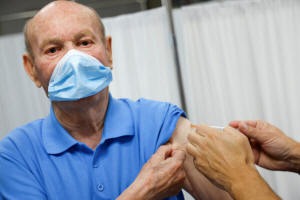Pandemic curbs linked to early start to Europe's winter flu season
 Send a link to a friend
Send a link to a friend
 [December 30, 2022]
By Natalie Grover [December 30, 2022]
By Natalie Grover
LONDON (Reuters) - Pandemic restrictions that hampered the circulation
of viruses other than COVID-19 could be behind the unseasonably early
upsurge in respiratory infections in Europe this winter that the festive
break could prolong, scientists say.
Apart from COVID-19, regulations to curb movement and social interaction
limited the transmission of viruses that typically cause most infections
during the colder, winter months, including influenza and RSV
(respiratory syncytial virus).
That created a bigger pool of susceptible people, including children
born during this time, who had less exposure to these viruses.
RSV usually causes mild, cold-like symptoms, but can result in serious
illness in older adults and young infants.
This winter, health officials have warned of what has been dubbed a
tripledemic of influenza, RSV and continued COVID-19 cases, adding to
the pressure on over-burdened health services.
RSV surveillance data from 15 European countries spanning the pre-COVID
years 2010-2011 to 2015-2016 show the median start to the RSV season is
early December, and that it peaks around the end of January, the ECDC
(European Centre for Disease Prevention and Control) highlighted in a
report published this month.
European trends so far suggest that this year RSV cases peaked in late
November and are in decline, but there will still be a substantial
number of cases in the next four to six weeks, said Agoritsa Baka, the
ECDC's expert in emergency preparedness and response.

In Wales, for instance, there were 111.6 confirmed RSV cases per 100,000
in children aged under five in the week ending Nov. 27.
For the 2018-2019 and 2019-2020 season, confirmed cases under the same
parameters were below 50. In both those years, even the eventual peaks,
which came a few weeks later, were just short of 50.
Meanwhile, COVID cases have risen in recent weeks. In the week ended Dec
18, European cases rose 7% over the week prior, according to ECDC
figures.
The flu upsurge began in the second week of November in the European
region, an earlier start than the four previous seasons, the agency
said.
"The accumulation of more susceptible persons in the last two years,
plus the increased mixing of people during the summer months (following
the easing of restrictions) have contributed to an earlier start of the
outbreaks in the current season 2022-2023," Baka said.
[to top of second column]
|

An elderly man receives a coronavirus
disease (COVID-19) vaccine booster coinciding with the flu
vaccination campaign in Seville, Spain October 18, 2021.
REUTERS/Marcelo del Pozo
 "We do not have any direct reference
for this statement," she said, but cited a study published by the
U.S. Centers for Disease Control and Prevention that linked sharp
declines in influenza circulation in the 2020-2021 season to
COVID-19 restrictions in the northern and southern hemispheres.
Peter Openshaw, a respiratory physician and professor at Imperial
College London, said it was plausible that limited social mixing in
recent years had contributed to a "downward drift" in specific
immunity to these viruses at a population level, alongside a decline
in general immunological responsiveness in people.
UNKNOWN TERRITORY
With little in the way of direct comparison with the situation this
year, it is unclear whether sharp peaks earlier than usual will
necessarily lead to a higher total number of cases over the season,
compared to pre-pandemic years.
But scientists are concerned that social interaction during the
festive season could lead to further increases in respiratory
infections, especially as people meet vulnerable elderly relatives.
"If you're sick - don't go to a party. Get tested before you go
visit your grandmother. And it would be prudent to wear a mask in
crowded places particularly in public transport," ECDCís Baka said.
As an added complication, viral respiratory infections can
predispose patients to bacterial infections, just when some common
antibiotics that can treat them are in short supply in Europe.
This has been linked to increased demand given an uptick in severe
infections caused by a bacteria called group A Streptococcus,
particularly in children under the age of ten.
Supply hiccups attributed to long-standing pricing pressure on the
manufacture of generic medicines in the continent that has worsened
with the energy crisis have added to the shortage.
(Reporting by Natalie Grover in London; Editing by Matt Scuffham and
Barbara Lewis)
[© 2022 Thomson Reuters. All rights
reserved.] This material may not be published,
broadcast, rewritten or redistributed.
Thompson Reuters is solely responsible for this content.
 |